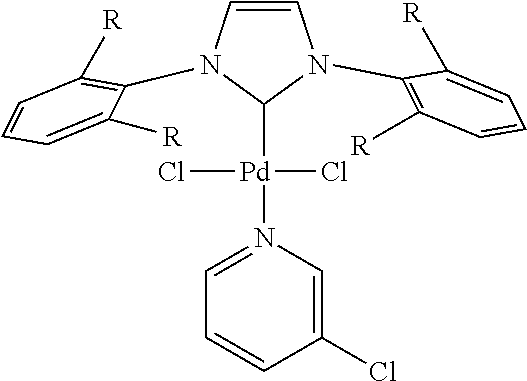Organic reactions carried out in aqueous solution in the presence of a hydroxyalkyl(alkyl)cellulose or an alkylcellulose
a technology of alkylcellulose and organic reaction, which is applied in the direction of group 313 element organic compounds, ether preparations, and separation/purification of carboxylic acid amides, etc., which can solve the problems of affecting the reaction efficiency, and posing significant risks to the environment and human handling
- Summary
- Abstract
- Description
- Claims
- Application Information
AI Technical Summary
Benefits of technology
Problems solved by technology
Method used
Image
Examples
examples
Abbreviations
r.t. room temperature (20 to 25° C.)
LCMS liquid chromatography mass spectrometry
t-Bu, tBu tert-butyl
O-t-Bu, OtBu tert-butanolate
KO-t-Bu, KOtBu potassium tert-butanolate
NaO-t-Bu, NaOtBu sodium tert-butanolate
OAc acetate
KOAc potassium acetate
EtOAc ethylacetate
OTf triflate
dtbpf 1,1′-bis(di-tert-butylphosphino)ferrocene
mida, MIDA N-methyliminodiacetic acid (see above)
Fmoc fluorenylmethoxycarbonyl
Val-OH L-valine
Fmoc-Val-OH N-(9-fluorenylmethoxycarbonyl)-L-valine
B2pin2 bis(pinacolato)diboron
[0892]In order to have reproducible conditions and exclude any (positive or negative) influence from the water used (e.g. from traces of metal or metal ions which may be present in common distilled water), Milli-Q® water was used. This Millipore Corporation trademark relates to ‘ultrapure’ water of “Type 1”, as defined by various authorities (e.g. ISO 3696). The purification processes involve successive steps of filtration and deionization to achieve a purity e...
preparation examples
II. Preparation Examples
[0907]1H-NMR: The signals are characterized by chemical shift (ppm) vs. tetramethylsilane, by their multiplicity and by their integral (relative number of hydrogen atoms given). The following abbreviations are used to characterize the multiplicity of the signals: m=multiplett, q=quartett, t=triplett, d=doublet, s=singlett, dd=doublet of doublets, dt=doublet of tripletts, dq=doublet of quartetts, ddd=doublet of doublets of doublets, td=triplett of doublets, tdd=triplett of doublets of doublets; tt=triplett of tripletts, br or=broad (e.g. sbr or bs=broad singlett).
1. Buchwald-Hartwig Reactions
General Procedure for Buchwald-Hartwig Aminations I
[0908][(π-allyl)PdCl]2 catalyst (0.005 eq), a phosphine ligand (0.020 eq) and a base (1.50 eq) were added under an Argon atmosphere into a 5.0 mL microwave vial containing a magnetic stir bar and Teflon-lined septum. HPMC in water solution (40-60 cps, 3 ml of 2 wt % in degassed Millipore water) was added under a positive f...
PUM
| Property | Measurement | Unit |
|---|---|---|
| viscosity | aaaaa | aaaaa |
| total weight | aaaaa | aaaaa |
| weight | aaaaa | aaaaa |
Abstract
Description
Claims
Application Information
 Login to View More
Login to View More - R&D
- Intellectual Property
- Life Sciences
- Materials
- Tech Scout
- Unparalleled Data Quality
- Higher Quality Content
- 60% Fewer Hallucinations
Browse by: Latest US Patents, China's latest patents, Technical Efficacy Thesaurus, Application Domain, Technology Topic, Popular Technical Reports.
© 2025 PatSnap. All rights reserved.Legal|Privacy policy|Modern Slavery Act Transparency Statement|Sitemap|About US| Contact US: help@patsnap.com



